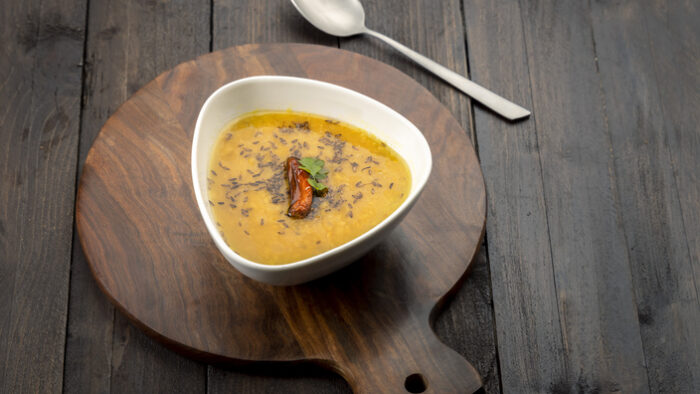Covid patients have sensory dysfunction and a profound weakness. The aroma of food is usually the first step in initiating the gut into a complex metabolic process of digestion
A vital aspect of life - aahara (the food we eat) - is often hampered in a corona-afflicted patient. Aahara is one of the Traya Upastambha (three anchoring piers or sub-pillars), according to Ayurveda. If the human body were a building, the vital supporting pillars that balance it and support the life within are aahara (food), nidra (sleep), and brahmacharya (mindful conduct in relationships). Extensively discussed in Ayurvedic treatises, these are the foundations of survival.
All food eaten must normally pass through the gastro-intestinal tract (GIT) in an uninterrupted flow. However, we see sensory dysfunction and a profound weakness in covid patients. The aroma of food is usually the first step in initiating the gut into a complex metabolic process of digestion. The first bite of food and its taste stimulates the salivary glands to secrete the necessary enzymes, further promoting smoother ingestion. In the absence of these senses of smell and taste, the desire to eat vanishes along with the essential salivary secretions. Thereafter, without the saliva, the sensation of chewing and swallowing is similar to having something dry and bland shoved down our throats, suppressing our appetite further. Hence, it necessitates flavor enhancers and easily digestible, nourishing, and energizing foods.
Moong daal and bottle gourd soup is a delicious recipe, even in curbed sensory perception during corona; it is a healthful delicacy that promotes goodness and immunity.
Moong daal shloka
कषायमधुरो रूक्षः शीतः पाके कटुर्लघुः|
विशदःश्लेष्मपित्तघ्नो मुद्गः सूप्योत्तमो मतः||
Source: Caraka Samhita, Sūtrasthana, chapter 27, sloka 23
Transliteration - kaṣāyamadhurō rūkṣaḥ śītaḥ pākē kaṭurlaghuḥ|
viśadaḥ ślēṣmapittaghnō mudgaḥ sūpyōttamō mataḥ||
Translation:
Kashaya, Madhura – astringent, sweet
Rooksha – dry
Sheeta – cold, coolant
Katu Vipaka – undergoes pungent taste conversion after digestion
Laghu – light to digest
Vishad – brings clarity to channels
Shleshma Pittaghna – balances Kapha and Pitta.
Of all the pulses, green gram is the best.
Mudga/moonga is an agrya food, one of the best in its category. This green gram is a daily recommended food. The term 'mudga' in Sanskrit means that which brings happiness.
When discussing the various types of jwara (fever), the acharyas prefer moong daal over others. It is considered to be the best pulse than edible dry peas, beans, lentils or chickpeas. It has a slightly sweet and astringent taste that provides a triple effect of nourishment, calming, and healing.
A special feature of mudga (moong) based on its physiological effect on the human body is that despite being sweet in taste, it is laghu (light to digest) and ruksha (dry). Most sweet-tasting foods are heavy and often moist. Due to this unique combination, it nourishes, promotes physical strength, and builds tissues. This property is called 'vichitra pratyarabdha' - green gram belongs to the category of substances possessing distinctive property 'a unity of paradoxes'. Therefore, it soothes the kapha and pitta doshas due to its cooling and drying properties. In addition, moonga is one of the few legumes beneficial for vitiated vata.

Moong daal can be consumed all year by people of all ages and body types, according to the ancient text of formulations Yogaratnakara, written c.1750 CE in Pali-Sinhalese on the prepared leaves of a talipot palm.. Moong is especially beneficial for the injured because it aids in wound healing. It is beneficial for throat disorders such as cough, tonsillitis, and pharyngitis and maintains thyroid gland health. It is recommended for conjunctivitis, glaucoma, dry eyes, and glare in vision. It improves the peristaltic motion of the gastrointestinal tract, provides nutrition to the body's tissues, alleviates heartburn symptoms, soothes the skin, and reduces rashes. When consumed regularly, it improves hair texture and density, strengthens the body, and balances gland secretions in general. It contains the most calcium, magnesium, phosphorus, manganese, and potassium of any legume.

Bottle gourd shloka
वर्चोभेदीन्यलाबूनि रूक्षशीतगुरूणि च| (ch. Su. 27/112)
Transliteration - varcoBedInyalAbUni rUkShaSItagurUNi ca|
cirBaTairvAruke tadvadvarcoBedahite tu te||112||
Translation - Alabu-the bottle-gourd (Lagenaria siceraria (Molina) Standl.) is a laxative, dry, cold in potency, and heavy.
Bottle gourd, also known as lokhi, lau, and calabash, is a climber described in Ayurveda to treat diabetes, jaundice jwara (fever), localized swellings, and skin disorders. It is a wonder veggie for cold, cough, asthma, chronic respiratory disorders, fever, toxic conditions, poisoning, inflammation, ulcers, wounds, and abdominal colic pain.
Why Soup?
In Ayurveda, soup is known as yusha. It is one of the preparations discussed in great detail in treating different types of jwara. Soup is the best choice during fevers as it kindles digestive fire, improves taste and appetite, aphrodisiac, improves voice quality, promotes physical strength, and induces sudation. The improved agni (digestive fire) thus combats aama (undigested food products stuck in the body) which tends to cause many more systemic diseases, the leading culprit of any disease in the body.
Spices
The spices used in the recipe enhance the taste and also the medicinal value of the soup. Haldi or turmeric imparts its antimicrobial and healing properties. It is also beneficial in respiratory disorders.
Asafoetida (heeng) and jeera aid in flavoring and work as appetizers and digestives. Ayurveda describes seven salts, the best of which is saindhava lavana or rock salt derived from the Sindh region of northwest India. Along with the natural minerals present in this salt composition, it aids in the relief of tastelessness experienced during any fever. Black pepper, known as maricha in Ayurveda, detoxifies, heals, and stimulates the organs; it has a pungent and bitter taste, is hot in potency, is easy to digest, aids in treating intestinal worms and heart diseases, improves taste perception, alleviates Kapha dosha, and cures diseases caused by vitiated Vata.
In the case of upper respiratory tract disorders, ginger is a go-to medicine. Green chilies are an excellent source of iron and a natural immune system booster. Curry leaves help to keep nausea at bay and are great stress relievers with healing properties. When ginger, green chili, and curry leaves are combined, they impart their respective flavors and make the recipe more palatable.

Moong daal and bottle gourd soup
Ingredients
Moong daal (Vigna radiata) - 1½ cup
Bottle gourd (Lagenaria siceraria) - 1 cup
Ginger (Zingiber officinale) - ½ inch
Green chilies (Capsicum annuum) - 2 to 3
Ghrita - 3 tsp
Jeera (Cuminum cyminum) - ½ tsp
Asafoetida (Ferula assa-foetida) - 2 pinch
Turmeric (Curcuma longa) - ½ tsp
Curry leaves (Murraya koenigii) 4-5
Black pepper (Piper nigrum) powder ½ tsp
Lemon juice 2 tsp
Coriander leaves for garnishing
clean water
Procedure
1. Soak 1½ cup of moong daal for 3 hours.
2. After soaking, rinse the soaked moong daal and keep it aside.
3. Heat 1 tablespoon of ghrita in a pot (having a concave and flat bottom, with a lid), on medium flame.
4. Add an inch of grated ginger and saute for 30 seconds without burning. Pour the soaked dal into it.
5. Mix it well and make sure each lentil is covered with a layer of ghrita.
6. Add a cup of bottle gourd and ½ a teaspoon of turmeric.
7. Saute for a couple of minutes.
8. Pour 3 cups of hot water into it. Mix well and cover it with the lid. Simmer on the same heat for 20-25 minutes.
9. Stir regularly so that the lentils and spices do not stick to the bottom. Add more water if required.
10. After 25 minutes or so, remove the lid and check for consistency. If the daal and bottle gourd breaks on pressing with a spoon, then the mix has cooked well.
11. In a separate small pan, heat two tablespoon of ghrita, and add jeera and asafoetida(heeng). In about 40 seconds, add chopped green chilies and curry leaves, and let it splutter. Add ½ teaspoon black pepper powder and immediately add ½ cup of water to this mix to prevent the prepared spices from burning.
12. Add the prepared tempering to the daal and bottle gourd in the pot, along with 2 teaspoon of saindhava lavana. Stir and mix well the complete contents and let it simmer for a minute.
13. Take off from the stove and add two tablespoons of lemon juice and garnish with coriander leaves.
Notes
- For the preparation, use steel or copper vessels. To avoid burning, a thick steel vessel can be used. Seasoned and prepared earthen pots can also be used.
- Because thin steel pots or copper vessels heat up quickly, it's important to stir frequently during the cooking process. Also, prepare the ingredients ahead of time to avoid burning.
- Maintain a low to medium constant flame throughout the cooking process, avoiding wind.





